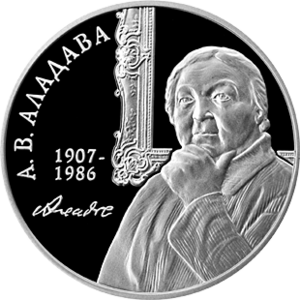Belarusian ruble facts for kids
Quick facts for kids Belarusian ruble |
|
|---|---|
| ISO 4217 Code | BYN |
| User(s) | |
| Inflation | 4.9% |
| Source | National Statistical Committee, December 2017 |
| Subunit | |
| 1⁄100 | kopeck |
| Symbol | Rbl |
| Plural | The language(s) of this currency belong(s) to the Slavic languages. There is more than one way to construct plural forms. See article. |
| Coins | |
| Freq. used | 1 cop, 2 cop, 5 cop, 10 cop, 20 cop, 50 cop, Rbl 1, Rbls 2 |
| Banknotes | |
| Freq. used | Rbls 5, Rbls 10, Rbls 20, Rbls 50, Rbls 100, Rbls 200 |
| Rarely used | Rbls 500 |
The ruble (Belarusian: рубель, romanized: rubieĺ; Russian: рубль, romanized: rubl'; abbreviation: Rbl, plural: Rbls) is the official money used in Belarus. It is divided into 100 smaller units called kopecks (Belarusian: капейка, romanized: kapiejka, Russian: копейка, romanized: kopeyka). The international code for the Belarusian Ruble is BYN.
Contents
History of the Belarusian Ruble
The First Ruble (BYB): 1992–2000
After the Soviet Union broke up, Belarus needed its own money. The government decided to create a new national currency because there wasn't enough cash. Some people suggested calling it the Thaler, but the government chose to stick with the name ruble, which had been used in Belarus for a long time.
The first Belarusian ruble (code: BYB) was introduced in May 1992. It replaced the old Soviet money. One new Belarusian ruble was worth 10 Soviet rubles. It took about two years for the ruble to become the only official money in the country.
The Second Ruble (BYR): 2000–2016
In 2000, Belarus introduced a new ruble (code: BYR). This was a big change called a redenomination. They removed three zeros from the old money. So, 1 new ruble was equal to 1,000 old rubles. At this time, only paper money (banknotes) were used. Coins were only made for collectors, not for everyday use.
Talks about joining money with Russia
Since 1994, the president of Belarus, Alexander Lukashenko, has talked about joining closer with Russia. There were ideas about having one shared currency for both countries. However, this plan never fully happened. The National Bank of the Republic of Belarus later decided to link its ruble to the United States dollar instead of the Russian ruble.
The Third Ruble (BYN): 2016–Present
In July 2016, Belarus introduced its newest ruble (code: BYN). This was another redenomination, where 1 new ruble was equal to 10,000 of the second rubles. For a few months, both the old and new rubles were used at the same time.
This time, Belarus also started using coins for the first time in its history. There are seven types of banknotes (5, 10, 20, 50, 100, 200, and 500 rubles) and eight types of coins (1, 2, 5, 10, 20, 50 copecks, and 1, 2 rubles). The banknotes show the year 2009, which was when they were first printed, even though they were released later.
Coins of Belarus
First Series of Coins: 2016
On December 27, 2016, Belarus finally introduced coins for regular use. Before this, Belarus was one of the few countries that didn't have coins. This was mainly because of high inflation, which made money lose its value quickly.
Slovakia helped by making the first coin designs. The coins are made from different metals. For example, the smallest coins (up to 5 copecks) are made of steel with a copper coating. The 1 ruble coin is nickel-plated steel, and the 2 ruble coin is made of two different metals.
All coins have the national emblem of Belarus on one side, along with the country's name and the year they were made. The other side shows the coin's value and different traditional symbols.
| 2016 Belarusian ruble coins | ||||||||||||||
|---|---|---|---|---|---|---|---|---|---|---|---|---|---|---|
| Image | Value |
Technical parameters | Description | Date of | ||||||||||
| Obverse | Reverse | Diameter (mm) |
Thickness (mm) |
Mass (g) |
Composition | Edge | Obverse | Reverse | first minting | issue | ||||
 |
 |
1 cop | 15 | 1.25 | 1.55 | Copper-plated steel | Plain | National emblem of Belarus, name of the country, year of minting | Value, the ornament symbolizing wealth and prosperity | 2009 | 1 July 2016 | |||
 |
 |
2 cop | 17.5 | 2.10 | ||||||||||
 |
 |
5 cop | 19.8 | 2.7 | ||||||||||
 |
 |
10 cop | 17.7 | 1.80 | 2.8 | Brass-plated steel | Reeded | Value, the ornament symbolizing fecundity and vital force | ||||||
 |
 |
20 cop | 20.35 | 1.85 | 3.7 | |||||||||
 |
 |
50 cop | 22.25 | 1.55 | 3.95 | |||||||||
 |
 |
Rbl 1 | 21.25 | 2.3 | 5.6 | Nickel-plated steel | Value, the ornament symbolizing the pursuit of happiness and freedom | |||||||
 |
 |
Rbls 2 | 23.5 | 2.0 | 5.81 | Brass-plated steel ring with a nickel-plated steel center plug | Lettered | National emblem of Belarus, name of the country, year of minting, divided by Bahach ornament | ||||||
Special Collector Coins
Belarus also makes many special coins for collectors. These coins are often made of gold or silver. Their designs can be very creative, showing things from Belarusian culture, fairy tales, or even pop culture. Most of these coins have a value of 1 ruble, but some are 3, 5 rubles, or more. These special coins are usually not used for buying things every day.
Banknotes of Belarus
First Ruble (BYB) Banknotes
Between 1992 and 1999, many different banknotes were printed for the first ruble. They ranged from 50 copecks up to 5,000,000 rubles.
| 1992 — 1999 series | ||||||||||
|---|---|---|---|---|---|---|---|---|---|---|
| Image | Value | Dimensions | Main Color | Description | Date of | |||||
| Obverse | Reverse | Obverse | Reverse | issue | withdrawal | lapse | ||||
 |
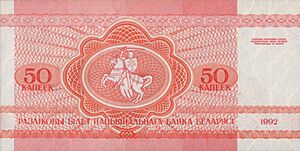 |
50 cop | 105 × 53 mm | Orange-pink | Image of sciurus | Pahonia ("The Chase") | 25 May 1992 | 1 January 2001 | 31 December 2000 | |
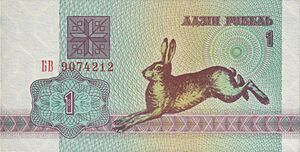 |
 |
Rbl 1 | Grey blue | Image of the running European hare or "zaichik" which earned the currency its nickname | ||||||
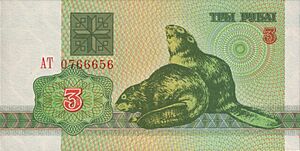 |
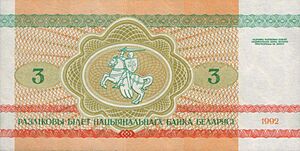 |
Rbls 3 | Green | Image of beavers | ||||||
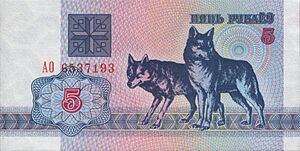 |
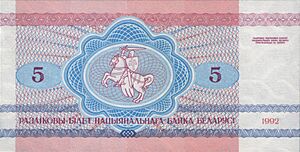 |
Rbls 5 | Blue and pink | Image of wolves | ||||||
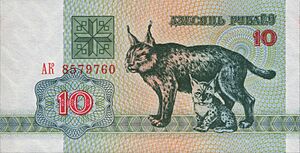 |
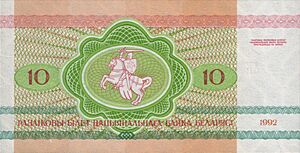 |
Rbls 10 | Dark green | Image of the Eurasian lynx with kitten | ||||||
 |
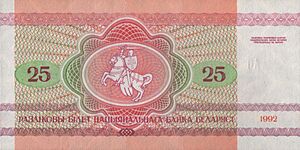 |
Rbls 25 | Orange | Image of moose | ||||||
 |
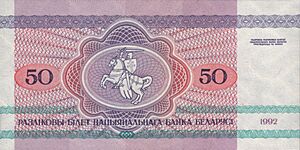 |
Rbls 50 | Violet | Image of brown bear | ||||||
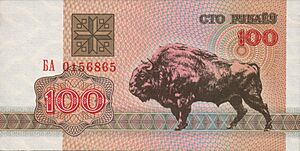 |
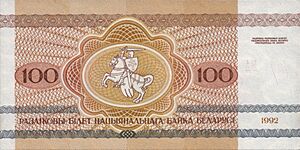 |
Rbls 100 | Green-brown | Image of wisent | ||||||
 |
 |
Rbls 200 | Yellow-green | Image of the train station square | 8 December 1992 | |||||
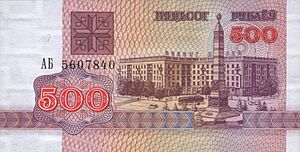 |
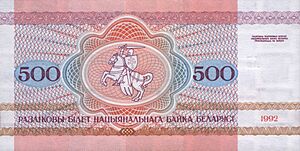 |
Rbls 500 | Violet-red | Victory Square, Minsk | ||||||
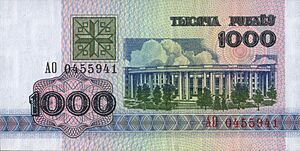 |
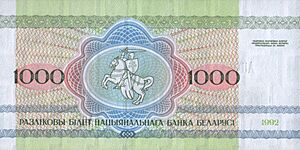 |
Rbls 1,000 | Green | National Academy of Sciences of Belarus in Minsk | 3 November 1993 | 31 December 2003 | ||||
 |
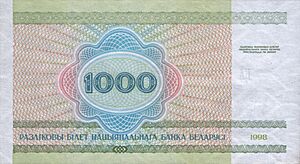 |
Rbls 1,000 | 110 × 60 mm | Large image of the number 1,000 | 16 September 1998 | |||||
 |
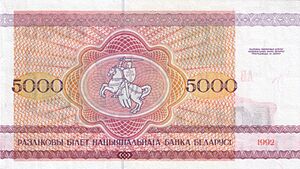 |
Rbls 5,000 | 105 × 60 mm | Red | Trinity Hill in Minsk | Pahonia | 7 April 1994 | |||
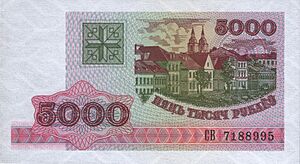 |
 |
Rbls 5,000 | 110 × 60 mm | Large image of the number 5,000 | 16 September 1998 | |||||
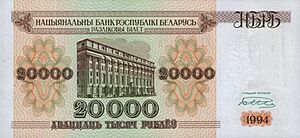 |
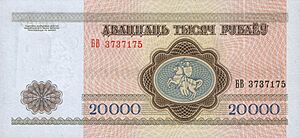 |
Rbls 20,000 | 150 × 69 mm | Olive-yellow | National Bank of the Republic of Belarus | Pahonia | 28 December 1994 | |||
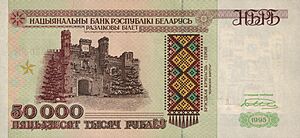 |
 |
Rbls 50,000 | Light brown | Kholm Gate | Brest Fortress Memorial | 15 September 1995 | ||||
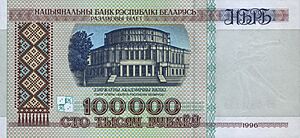 |
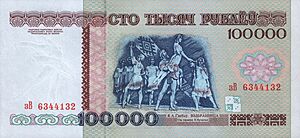 |
Rbls 100,000 | Grey-brown | Opera and Ballet Theatre (Minsk) | Scene from the ballet "Favourite" («Избранница») by E.A. Hlebau | 17 October 1996 | ||||
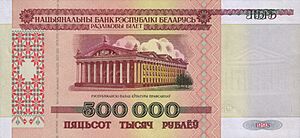 |
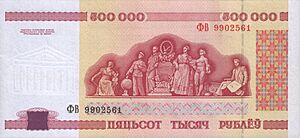 |
Rbls 500,000 | Orange-red | The Republican Trade Unions' Palace of Culture in Minsk | Architectural decorations on the Republican Palace of Culture of Belarus | 1 December 1998 | ||||
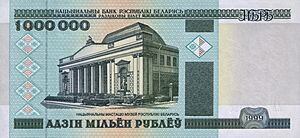 |
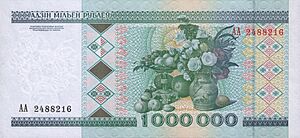 |
Rbls 1,000,000 | Sky-blue | The National Museum of Arts of Belarus in Minsk | Fragment of the picture "Portrait of wife with flowers and fruits" by I. Khrutski | 30 April 1999 | ||||
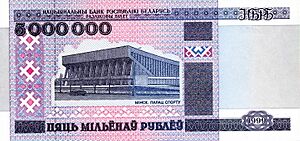 |
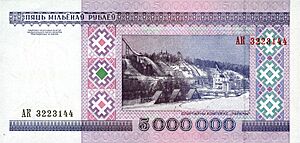 |
Rbls 5,000,000 | Light violet | Minsk Sports Palace | Image of the "Raubichy" sports complex | 6 September 1999 | ||||
Second Ruble (BYR) Banknotes
The second ruble banknotes were introduced in 2000. They started with values from 1 to 5,000 rubles. Later, higher values like 10,000, 20,000, 50,000, 100,000, and 200,000 rubles were added. During this time, there were no copeck coins or banknotes.
In 2010, the spelling rules for the Belarusian language changed. This meant that the words for "fifty" on the 50 and 50,000 ruble notes were no longer correct. So, new versions of these banknotes were printed to fix the spelling.
| 2000 Series | |||||||||
|---|---|---|---|---|---|---|---|---|---|
| Image | Value | Dimensions | Main Color | Description | Date of | ||||
| Obverse | Reverse | Obverse | Reverse | issue | withdrawal | lapse | |||
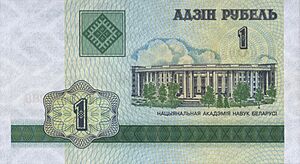 |
 |
Rbl 1 | 110 × 60 mm | Green | The building of the National Academy of Sciences of Belarus | Denomination in figures | 1 January 2000 | 1 January 2003 | 31 December 2003 |
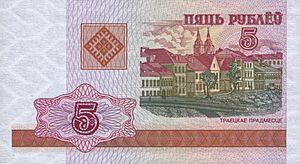 |
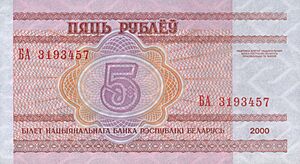 |
Rbls 5 | Rose-red | View of the Trayetskaye Pradmyestsye in Minsk | 1 September 2004 | 30 June 2005 | |||
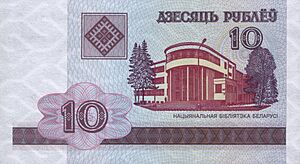 |
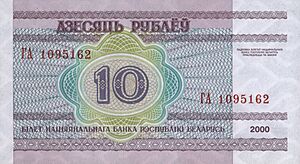 |
Rbls 10 | Light blue | The building of the National Library of Belarus | 1 March 2013 | 31 March 2014 | |||
 |
 |
Rbls 20 | 150 × 69 mm | Olive-yellow | The building of the National Bank of Belarus | The interior of the building of the National Bank of Belarus | |||
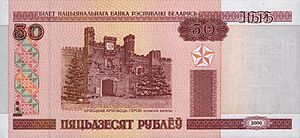 |
 |
Rbls 50 | Orange-red | The Kholm Gate - fragment of the Memorial Brest Hero-Fortress | The main entrance to the Memorial Brest Hero-Fortress | 1 July 2015 | 1 July 2016 | ||
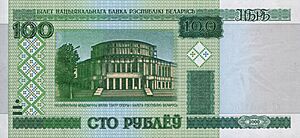 |
 |
Rbls 100 | Green | The National Academic Great Opera and Ballet House of Belarus in Minsk | Scene from ballet "Favourite" by E.A. Hlebau | 1 January 2017 | 1 January 2022 | ||
 |
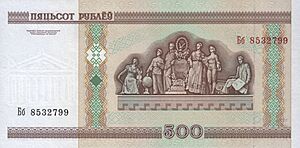 |
Rbls 500 | 150 × 74 mm | Light brown | The Republican Trade Unions' Palace of Culture in Minsk | Architectural decorations on the Republican Palace of Culture of Belarus | |||
 |
 |
Rbls 1,000 | Light blue | The National Museum of Arts of Belarus in Minsk | Fragment of the picture "Portrait of the wife with flowers and fruits" by I. Khrutski | ||||
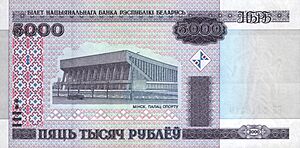 |
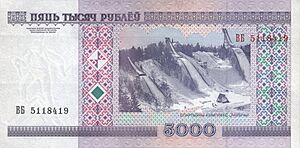 |
Rbls 5,000 | Light violet | Minsk Sports Palace | Image of the "Raubichy" sporting complex | ||||
 |
 |
Rbls 10,000 | Pink | Panorama of Vitebsk city | Summer amphitheatre in Vitebsk | 16 April 2001 | |||
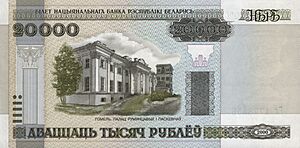 |
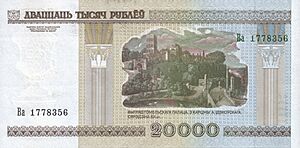 |
Rbls 20,000 | Grey | Gomel Palace | A view of the palace from A. Idzkouski's picture in Homyel | 21 January 2002 | |||
 |
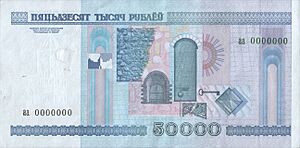 |
Rbls 50,000 | Sky blue | A castle in the settlement of Mir, Karelichy district, Grodno Region | Decorative collage of architectural elements of Mir Castle | 20 December 2002 | |||
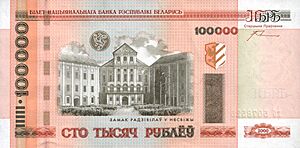 |
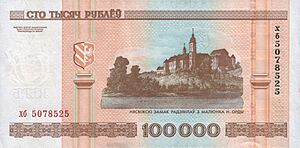 |
Rbls 100,000 | Orange | The Nesvizh Castle | View of the Radziwills' Castle in Niasvizh from a painting by the Belarusian artist Napoleon Orda | 15 July 2005 | |||
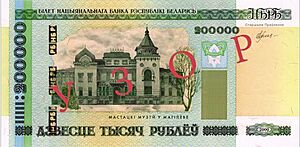 |
 |
Rbls 200,000 | Light green | The Mogilev Maslennikov Art Museum | Decorative collage of architectural elements of the museum building | 12 March 2012 | |||
Third Ruble (BYN) Banknotes
The newest banknotes (BYN) were released in 2016. They come in values from 5 to 500 rubles. These banknotes were printed by a company in the United Kingdom called De La Rue. The coins were made in Lithuania and Slovakia.
Both the banknotes and coins were actually ready in 2009. However, a financial crisis meant they couldn't be used right away. They had to wait seven years until the economy was more stable and inflation was lower. Their designs look quite similar to the euro banknotes.
| 2009 Series | ||||||||||
|---|---|---|---|---|---|---|---|---|---|---|
| Image | Value | Dimensions | Main Color | Description | Date of | |||||
| Obverse | Reverse | Obverse | Reverse | printing | issue | withdrawal | lapse | |||
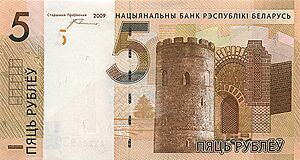 |
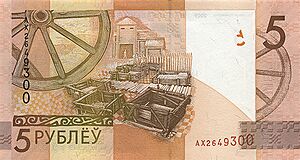 |
Rbls 5 | 135 × 72 mm | Orange | Belaya Vezha in Kamyanyets | collage on the theme of the first Slavic settlements | 2009 2019 2020 2022 (5, 10, 20, 50 and 100 ruble banknotes) |
1 July 2016 | Current | Current |
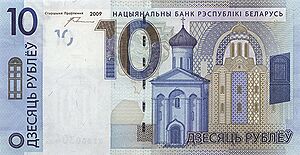 |
 |
Rbls 10 | 139 × 72 mm | Light Blue | Transfiguration Church in Polatsk | collage on the theme of enlightenment and printing | ||||
 |
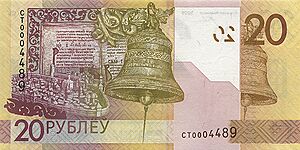 |
Rbls 20 | 143 × 72 mm | Yellow | Rumyantsev-Paskevich Residence in Homyel | collage on the theme of spirituality | ||||
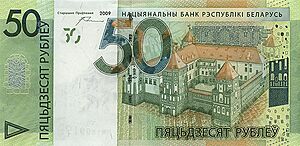 |
 |
Rbls 50 | 147 × 72 mm | Green | Mir Castle in Mir | collage on the theme of art | ||||
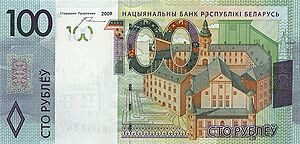 |
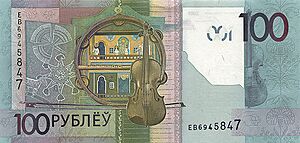 |
Rbls 100 | 151 × 72 mm | Turquoise | Niasvizh Castle in Nesvizh | collage on the theme of theater and folk holidays | ||||
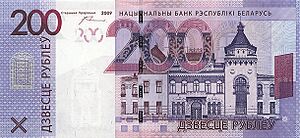 |
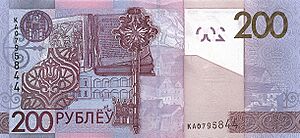 |
Rbls 200 | 155 × 72 mm | Violet | Regional Museum of Art in Mahilyow | collage on the theme of crafts and town-planning | ||||
 |
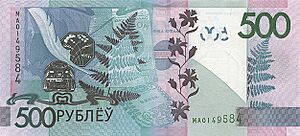 |
Rbls 500 | 159 × 72 mm | Pink and Blue | The building of the National Library of Belarus in Minsk | collage on the theme of literature | ||||
Exchange Rates
The value of the Belarusian ruble has changed a lot over the years.
- On January 2, 2009, the National Bank of Belarus cut the ruble's value by 50%.
- On May 24, 2011, they lowered it again by 56%.
- On October 20, 2011, the ruble's value dropped by 42% against the US dollar.
- In January 2015, the currency was devalued by 23% against the US dollar.
- In March 2022, during events related to the 2022 Russian invasion of Ukraine, the ruble reached a very low point against the US dollar.
- From July 2022 to October 2023, the currency's value was kept stable to help pay off debts. Since then, its value has remained fixed.
| Current BYN exchange rates | |
|---|---|
| From Google Finance: | AUD CAD CHF EUR GBP HKD JPY USD RUB EUR JPY |
| From Yahoo! Finance: | AUD CAD CHF EUR GBP HKD JPY USD RUB EUR JPY |
| From XE.com: | AUD CAD CHF EUR GBP HKD JPY USD RUB EUR JPY |
| From OANDA: | AUD CAD CHF EUR GBP HKD JPY USD RUB EUR JPY |
| From fxtop.com: | AUD CAD CHF EUR GBP HKD JPY USD RUB EUR JPY |
See also
 In Spanish: Rublo bielorruso para niños
In Spanish: Rublo bielorruso para niños
- Economy of Belarus
- Ruble


